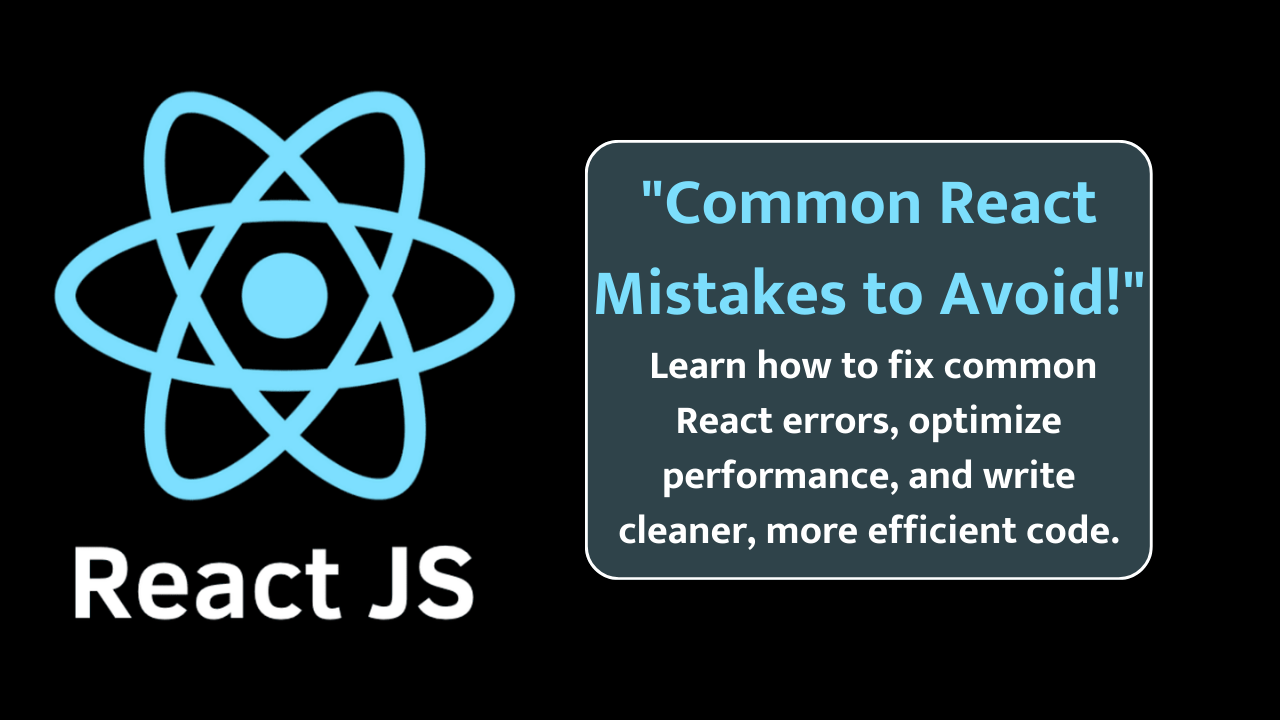Common Mistakes in React Development and How to Avoid Them
1. Improper Use of State
One of the most common mistakes developers make is mismanaging the state. For example, using too much state or placing state in the wrong component can make your application unnecessarily complex.
How to Avoid:
Identify the minimal amount of state you need for your app.
Use functional components and useState or useReducer for managing state efficiently.
Lift the state up to the closest common ancestor only when needed. Avoid passing down props unnecessarily.
2. Ignoring Key Props in Lists
When rendering lists in React, developers often forget to use unique key props. Using improper keys, such as array indices, can cause rendering issues.
How to Avoid:
Always provide unique and stable keys, such as a unique ID from the data.
Never use array indices as keys, as they can lead to incorrect rendering during updates.
3. Overusing Inline Functions
Using inline functions (e.g., onClick={() => handleClick()}) inside JSX may seem convenient, but it can lead to performance issues due to unnecessary re-creations of functions on every render.
How to Avoid:
Define functions outside of your JSX or use the useCallback hook to memoize them.
For example:
console.log(“Clicked”);
}, []);
4. Not Using React Fragments
Using unnecessary <div> elements as wrappers can lead to “div soup,” cluttering your DOM structure.
How to Avoid:
Use React Fragments (<></> or <React.Fragment>) to group elements without adding extra nodes to the DOM.
Example:
<>
<h1>Title</h1>
<p>Description</p>
</>
);
5. Ignoring Component Reusability
Developers sometimes write duplicate code instead of creating reusable components, leading to higher maintenance costs.
How to Avoid:
Identify common patterns or repeated UI elements and abstract them into reusable components.
Pass data and behavior through props to make components flexible.
6. Not Optimizing React Performance
Poor performance optimization, such as excessive re-renders or large bundle sizes, can slow down your app.
How to Avoid:
Use React’s React.memo to prevent unnecessary re-renders for functional components.
Split your code using dynamic imports with React’s lazy and Suspense.
Optimize state updates by batching them and avoiding deep cloning of objects unnecessarily.
7. Improper API Calls
Fetching data directly inside components without proper error handling or cleanup can lead to memory leaks and performance bottlenecks.
How to Avoid:
Use useEffect to fetch data properly and clean up effects when necessary.
Example:
let isMounted = true;
fetchData().then(data => {
if (isMounted) {
setData(data);
}
});
return () => (isMounted = false);
}, []);
8. Skipping Prop Validation
Mistake:
Ignoring prop validation can lead to unexpected behaviors or bugs.
How to Avoid:
Use PropTypes or TypeScript for prop validation.
Example with PropTypes:import PropTypes from “prop-types”;
MyComponent.propTypes = {
name: PropTypes.string.isRequired,
age: PropTypes.number,
};
9. Not Using Error Boundaries
Mistake:
React apps without error boundaries crash entirely when an error occurs in a child component.
How to Avoid:
Wrap your components with error boundaries to handle errors gracefully.
Example:class ErrorBoundary extends React.Component {
constructor(props) {
super(props);
this.state = { hasError: false };
}
static getDerivedStateFromError() {
return { hasError: true };
}
render() {
if (this.state.hasError) {
return <h1>Something went wrong.</h1>;
}
return this.props.children;
}
}
10. Not Updating Dependencies in useEffect
Mistake:
Forgetting to add dependencies in the dependency array of useEffect can cause bugs or infinite loops.
How to Avoid:
Always specify all necessary dependencies in the dependency array.
Use ESLint rules like react-hooks/exhaustive-deps to catch missing dependencies.
11. Hardcoding Values
Mistake:
Hardcoding values like strings and numbers directly inside components can make them less flexible and harder to maintain.
How to Avoid:
Use constants or configuration files to store hardcoded values.
This approach ensures you can update values in one place without modifying multiple files.
12. Ignoring Accessibility
Mistake:
Not paying attention to web accessibility (e.g., missing alt attributes or ARIA roles) can lead to a poor user experience for people with disabilities.
How to Avoid:
Follow accessibility standards, such as WCAG.
Use semantic HTML and React’s accessibility props.
Test your app using screen readers.
13. Improper Handling of Forms
Mistake:
Managing forms without using best practices can lead to uncontrolled inputs and messy code.
How to Avoid:
Use controlled components to manage form inputs.
Consider using libraries like Formik or React Hook Form for large forms.
14. Not Keeping Up With React Updates
Mistake:
Using outdated versions of React can cause compatibility issues and miss out on performance improvements.
How to Avoid:
Regularly update your React version and related packages.
Read the React documentation or release notes for breaking changes and new features.
15. Using Large Component Files
Mistake:
Writing overly large component files makes code harder to read and maintain.
How to Avoid:
Break down large components into smaller, logical units.
Follow the single-responsibility principle for components.
Final Tips for React Development
Code Reviews: Regular code reviews can help catch mistakes early.
Testing: Use tools like Jest or React Testing Library to test your components.
Learning Resources: Stay updated with the latest best practices by following React blogs and communities.
By avoiding these common mistakes and following best practices, you can build high-quality, maintainable, and efficient React applications. Whether you’re a beginner or an experienced developer, continuously refining your skills is the key to mastering React.
Make sure to implement these strategies in your next React project to see the difference!


![Top Python Interview Topics: A Beginner’s Guide for Students [Latest 2025]](https://developer.thrend.in/wp-content/uploads/2025/11/ChatGPT-Image-Nov-18-2025-02_21_01-PM.png)
